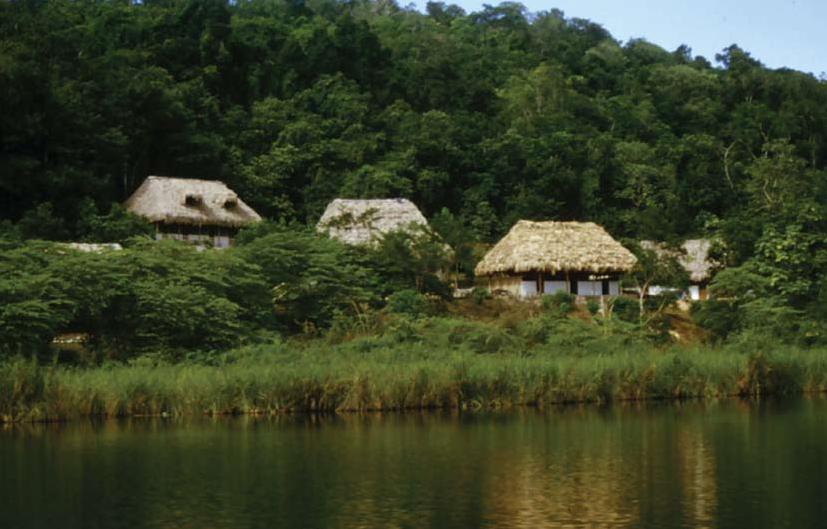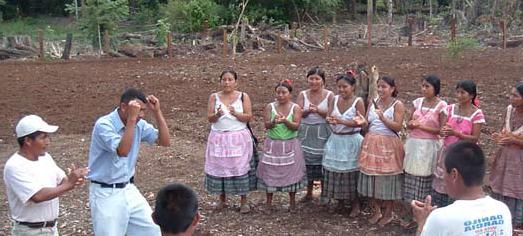
This article recounts the 2002-03 separation of a Guatemalan NGO called ProPetén from Conservation International (CI). As one of the cases cited by both Bray and Anderson’s (2005) report and Chapin’s (2004) seminal article, ‘A Challenge to Conservationists,’ the previously unpublished details
of this organisational divorce illustrate the divergence of local environmental interests from the increasingly neoliberal agenda of large, transnational conservation organisations, as described by other journalists and academics such as MacDonald (2008), Dowie (2009), and Igoe and Sullivan (2008).
To begin, I must disclose that before becoming a cultural anthropologist, I worked for CI’s Guatemala program (a.k.a. ProPetén) for five years between
1993-1999 (7 months in DC and 4 years in the Petén, Guatemala, field office) as a volunteer, intern, affiliated Fulbright researcher, and eventually paid staff. Because of my long-term commitment to the project, my former Guatemalan colleagues invited me and one other North American anthropologist to join its founding board of directors when planning began in 2002 to legalise ProPetén as an independent NGO. Having moved back to Petén for dissertation research between September 2002 and May 2004, I was present and involved with all the events described herein as secretary (2002-03), then president (2003-05), and finally emeritus advisor (2005- present) of this new board of directors. All events described in this article are documented in my fieldnotes, email records, and/or organisational archives. The contextual explanations of the growing schism between ProPetén and CI over several ‘springs’ are based on my anthropological interpretation of events and should not be interpreted as an official ProPetén statement.
Spring 1990. Described romantically in the travel-writing genre as the ‘land of eternal spring,’ Guatemala’s natural beauty also constitutes a central part
of the planet’s third most important biodiversity ‘hotspot’ (according to CI’s own internal ranking system). Following Guatemala’s 1990 declaration of the 1.6 million hectare Maya Biosphere Reserve in northern Guatemala (a complex of national parks surrounded by multiple-use and buffer zones), CI won the largest grant offered by USAID-Guatemala for community-based conservation efforts in this region. Charged with providing economic alternatives to deforestation for communities located inside the Reserve, CI established a field office called ‘ProPetén’ and hired a talented, local Guatemalan team.
Over the next several years, ProPetén launched a series of successful flagship projects in ecotourism, sustainable timber management, non-timber forest products, primary and reproductive health, and environmental education that helped CI to gain credibility among more bi- and multi-lateral donors and build its global brand as an organisation with a mission ‘to demonstrate that human societies are able to live harmoniously with nature.’
Spring planning meetings, late 1990s. Building on the success of CI’s initially decentralised structure that empowered national directors to make
good decisions based on the local context, money began to flow into CI’s global coffers. To meet the needs of its new multilateral and corporate
donors, headquarters leadership also began to demand more reports, more budget requisitions, more vertical communication, and more complicated
planning frameworks from its field staff. Little by little, national directors lost the autonomy they held in the early 1990s. At almost every annual
planning meeting (always held in the spring) around the millennium turn, CI’s CEO and President announced the creation of a new DC-based and
-staffed initiative (e.g., the Center for Applied Biodiversity Science in 1999, the Center for Leadership in Business in 2001, among others). The absence of a ‘center’ led by social scientists to support partnerships with grassroots, indigenous, or communitybased organisations was notable. While many kinds of organisations (corporate, nonprofit, governmental) develop structural tensions between satellite offices and headquarters, CI’s disproportionate growth in DC staff over field staff exacerbated these normal internal divisions. Adding to the tensions was a cultural clash between an increasingly corporate management style at headquarters and the more diverse and pragmatic management styles of community-based
field programs.
Spring 2000. After having been heralded as CI’s poster project for a decade, ProPetén’s leadership began hearing murmurs from DC staff that they were doing too much ‘development’ and wasting ‘scarce’ conservation dollars on ‘poverty alleviation’ instead of focusing on strict biodiversity conservation. Precisely as CI’s central management had begun to question its community-based field programs, USAID-Guatemala also happened to be closing down the tenyear Maya Biosphere Reserve initiative. For over a decade, CI headquarters had negotiated the maximum NICRA (Negotiated Indirect Cost Recovery Agreement) rate from USAID, which meant that it collected an average of 38 per cent in overhead fees from ProPetén’s million dollar-plus annual grant. Once a major source of revenue for CI, the ProPetén field office was soon to become a liability. Without consulting its Guatemalan field staff, CI’s President Russell Mittermeier wrote a memo to USAID-Guatemala pledging to establish ProPetén ‘as a fully independent non-governmental organisation under Guatemalan law’ within seven months, following which ‘CI will continue to act as an associate, providing technical support and advice as needed….’ (21 December 2000).
Spring 2002. Two years later, the swift and amicable separation promised by Mittermeier to USAID began to sour into prolonged and bitter divorce. To be fair, ProPetén was not the only local organisation that experienced problems in becoming legally independent of its international counterpart asUSAID Guatemala closed down the original Maya Biosphere Reserve project; Defensores de la Naturaleza / TNC, CARE-Petén / CARE International, and Centro Maya / Rodale all had their own disagreements. However, of all these organisations, ProPetén and CI suffered the longest and most acrimonious separation process with disagreements along three lines: (a) ownership of a local biological station, (b) budgetary issues, and (c)philosophical approaches to ‘business’ and the environment. The most contentious point of separation was over future ownership of ProPetén’s biological research station located in a conflictive region of Laguna del Tigre National Park. Bypassing the ProPetén field office, a pair of CI biologists traveled directly to the station in early 2002 to draw up an inventory and a ‘co’-management plan in which CI would take control of the station and leave ProPetén with the more difficult, conflictive, and sometimes physically dangerous community relations with surrounding villages. According to their budget,
CI would contribute nothing to the community projects, but ProPetén would be expected to raise 50 per cent of the station’s research and operating
budget. After ProPetén rejected this lopsided plan, CI then proposed partnering with other NGOs unfamiliar with the local context to ‘co’-manage the station. Both these proposals were unacceptable to the Guatemalan staff who had risked their lives defending the property after loggers tricked local communities into burning it down days before its planned inauguration in 1997. CI refused to contribute funds for the station’s reconstruction, so ProPetén’s director decided to raise the money himself from the Japanese embassy in Guatemala city for a more humbly designed facility built with local materials that would be less of a target for arson. As a space for Guatemalan biologists and university students to carry out applied research involving local villages, the station’s scientific program was perhaps not as glamorous as CI’s famous ‘rapid assessment programs’ for inventorying biodiversity, but it contributed significantly to the formation of a committed class of conservation professionals in Guatemala. Moreover, the health and agricultural training programs that ProPetén then organised at the station also developed a network of neighboring village leaders willing to cooperate with conservation activities.
As such, the station became a symbol of national sovereignty for he ProPetén team, university students, and local people — and was simply not
negotiable. The conditions of CI’s long-term financial commitment to continued conservation work in Petén became a second point of contention.
Uncertain whether CI would pay them the pensions due to them under Guatemalan law, ProPetén’s employees threatened to sue in the early spring
of 2002. Under some pressure from USAID-Guatemala, CI did pay the pensions and also promised in May 2002 to relinquish the station, provide
USD 100,000 in general start-up funding, delegate all outstanding project funds (USD 86,287 from twelve donors), and transfer all other fixed assets accrued over the life of the USAID program to ProPetén by the end of that fiscal year. June passed with no further word from CI. ProPetén was
born as a Guatemalan NGO with 57 employees and not a cent in the bank. Not until August did CI give half the promised start-up money (USD
50,000) but held onto the other funds and assets. ProPetén began to lay off workers, eventually losing more than half its original staff.

As the months rolled by, ProPetén’s board realised the DC accountants were trying to reassign the aforementioned pension payments to ProPetén’s start-up budget and other project balances. CI’s lawyers also continued to quibble over ProPetén’s shares in an ecotourism alliance (‘Eco- Maya’) and attempted to renege upon debts CI acquired from a failed microcredit fund (‘Fondo Maya’) planned and established by DC-based staff in the 1990s. While ProPetén’s board complied with CI’s request for a ‘gentlemen’s agreement’ not to speak of these troubles to any donors, we later learned that CI had secretly communicated with ProPetén’s twelve donors asking them to reassign outstanding balances to other divisions of CI’s multimillion
budget. Trusted friends in DC confided that CI had tried to block a medium-sized grant that ProPetén was poised to receive from the Global Environmental Facility (GEF) to implement a three-year project in partnership with an indigenous-led NGO called the BioItzá Association. While the GEF grant proceeded normally, CI did manage to block a pass-through grant (an anticipated USD 300,000) that ProPetén was to receive from USAID/Washington’s Population and Environment program in recognition of its successful ‘Remedios’ program. After failing to contract another Guatemalan NGO (with no previous experience in Petén) for this project, CI diverted this funding to another country program.Spring 2003. Following the unexpected loss of ProPetén’s executive director to liver cancer in May 2003, USAID Guatemala officers renewed pressure on CI to honor its legal commitments to ProPetén. After more months of delays, CI finally transferred the biological station and fixed assets to a deeply weakened ProPetén in July 2003, although CI’s 990 form for 2001 available online reveals that the organisation had already claimed to the IRS USD 243,344 for a ‘transfer to local NGO in Guatemala.’
Subsequent tax reports show that after squabbling over relatively small budget amounts with ProPetén (in CI’s terms, not ProPetén’s), CI immediately donated USD 471,000 to the Wildlife Conservation Society (WCS) for projects in Petén in 2004, illustrating a pattern of ‘strange bedfellows’ described by Christine McDonald in Green Inc. in which ‘big industry groups and big conservation groups that seem like logical rivals end up in alliances, partnerships, and pacts’ (2008: 204). While CI’s leadership internally dismissed the ugliness of the ProPetén divorce to other CI staff as caused by ‘personality conflicts,’ the irreconcilable differences between the two organisations actually went deeper. Working in a densely populated region with thousands of farmers also living inside the Maya Biosphere Reserve, ProPetén remained committed to community-based partnerships as the best methodology for biodiversity conservation. CI, however, had begun to move up the economic scale to establish multiple partnerships with corporations such as Monsanto, Alcoa, Anheuser- Busch, BP, Fiji Water, Chevron Corporation, ConocoPhillips, Ford Motor Company, Rio Tinto, Royal Caribbean Cruises, S.C. Johnson &Son, Shell Oil, Starbucks, even Wal- Mart. Representatives of many of these corporations also garnered influential seats on CI’s board of directors.
To be clear, ProPetén’s Guatemalan leadership was not opposed to engaging with the market, per se, but they wanted to help communities develop
economic interests in conservation at a scale and pace that local people could manage themselves. This meant,for example, supporting projects to
help women’s groups sell artisanal herbal products locally rather than making bioprospecting agreements with pharmaceutical corporations (as CI’s lawyers once proposed in 1999). It also meant supporting local ecotourism businesses rather than signing partnerships with large hotel owners and other corporate players involved in the Inter-American Development Bank’s controversial Puebla to Panama Plan (as CI did in 2002). Another serious disagreement concerned whether ProPetén should continue a decade of village extension work to establish certified community run forest concessions or switch to complicated, top-down carbon-trading being leases (as proposed by CI in 2002).
The very same DC-based economists that had argued in the early 1990s that ProPetén must help communities ‘use it or lose it’ began to
argue the opposite by the late 1990s: that ‘direct conservation’ (i.e., paying villagers leases not to harvest their trees) was the more cost-effective approach. The problem with the economists’ proposed carbon trading scheme for Petén was that it only offered short term funding to just two village groups – threatening the unity and marketing of the other 21 other community forest concessions operating in the Maya Biosphere Reserve. When the Guatemalan park service eventually rejected CI’s plan for these and other reasons, the DC economists accused ProPetén’s executive director of not demonstrating sufficient enthusiasm for their plan in meetings with the Guatemalan government. As these and other examples reveal, ProPetén’s staff had broadened their environmental philosophy to integrated concerns about ecological and human welfare, much in the same way that the 1962 publication of Rachel Carson’s Silent Spring had expanded U.S. environmentalism from its origins among a small band of elites interested on wilderness preservation into an expanded social movement involving new constituencies such as housewives, students, inner-city residents, and factory workers. CI unfortunately remained devoted to a technical and increasingly corporate model of biodiversity conservation myopically focused on park preservation.
Six years after its financial and ideological separation from CI, ProPetén has rebuilt itself under the leadership of two dynamic Guatemalan women, Rosa Maria Chan and Rosita Contreras. As an independent Guatemala organisation, ProPetén not only continues to support community-based
conservation, but has also joined popular and agrarian struggles against corporate trade and neoliberalism and embraced other environmental justice issues to establish a greener life not only for the forest, but also for the people of the land of eternal spring.
References:
Bray, D.B. and A.B. Anderson. 2005. Global Conservation, Non- Governmental Organization, & Local Communities: Perspectives on
Programs and Project Implementation in Latin America. Working Paper No.1. Conservation and Development Series. Latin American and Caribbean
Center, Florida International University, Miami.
Chapin, M. 2004. A Challenge to Conservationists. World Watch November/December:17-31.
Dowie, M. 2009. Conservation Refugees: The Hundred-Year Conflict between Global Conservation and Native People. Boston: MIT Press.
Igoe, J. and S. Sullivan. 2008.Problematizing Neoliberal Biodiversity Conservation: Displaced and Disobedient Knowledge. Wenner Gren Workshop, American University, Washington, DC. 25 pp.
MacDonald, C. 2008. Green, Inc.: An Environmental Insider Reveals How a Good Cause Has Gone Bad. Guilford, CT: The Lyons Press.





